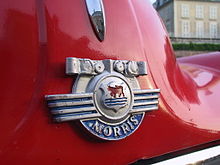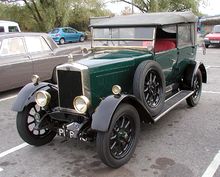- Morris Motor Company
-
See also: Morris Commercial CarsSee also: MG
Morris Motor Company 
Industry Automotive Fate Merged Successor British Motor Corporation Founded 1910 Defunct 1952 (marque used until 1984) Headquarters Cowley, Oxford, Oxfordshire, England Key people William Morris Morris Marque 
Type Automotive marque Owner SAIC Discontinued 1987 Previous owners Morris (1910-1952)
BMC (1952-1967)
British Leyland (1967-1986)
Rover Group (1986-1988)
BAe (1988-1994)
BMW (1994-2000)
NAC (2000-2007)The former Morris engine factory, now called The William Morris Building, part of Coventry University. (photo 2007)
 Morris badge, on a Royal Mail van
Morris badge, on a Royal Mail van
The Morris Motor Company was a British car manufacturing company. After the incorporation of the company into larger corporations, the Morris name remained in use as a marque until 1984 when British Leyland's Austin Rover Group decided to concentrate on the more popular Austin marque. The trademark is currently owned by SAIC after being transferred from bankrupt subsidiary Nanjing Automotive.
Contents
History
Early history
The Morris Motor Company was started in 1910 when bicycle manufacturer William Morris turned his attention to car manufacturing and began to plan a new light car. A factory was opened in 1913 in a former Oxford Military College at Cowley, Oxford, United Kingdom, and the company's first car, the 2-seat Morris Oxford "Bullnose" was introduced.[1] Nearly all the major components were bought-in, with only final assembly being undertaken in the Morris works. In 1914 a coupé and van were added to the line-up but the chassis was too short and the 1018 cc engine too small to make a much-needed 4-seat version of the car. White and Poppe, who made the engine, wanted more money than Morris was prepared to pay for a larger version, so the company turned to Continental of Detroit, Michigan, for supplies of a 1548 cc unit.[1] Gearboxes and axles were also sourced in the US. In spite of the outbreak of the First World War the orders were maintained and, from mid-1915 a new larger car, the 2-seat and 4-seat Morris Cowley was introduced.
Inter-war years
After the war the Continental engine was no longer available, so Morris arranged for the French company Hotchkiss to make a near-copy in their Coventry factory. This was used to power new versions of the basic Cowley and more up-market Morris Oxford cars. With a reputation for producing high-quality cars and a policy of cutting prices, Morris Motor Company continued to grow and increase its share of the British market and, in 1924, overtook Ford to become the UK's biggest car manufacturer, holding a 51% share of the home market. They had a policy of buying up suppliers with, for example, Hotchkiss in Coventry becoming the Morris Engines branch in 1923. In 1924 the head of the Morris sales agency in Oxford, Cecil Kimber, started building sporting versions of Morris cars, called MG – after the agency, Morris Garages. The MG factory was in Abingdon, Oxfordshire.
The small car market was entered in 1928, with the Morris Minor, using an 847 cc engine from the Wolseley Motor Company, a company which became part of Morris Motors Company in 1927. This helped the company through the economic depression of the time. The Minor was replaced at the 1934 London Motor Show by the Morris Eight, a direct response to the Ford Model Y and heavily based on it. In 1932 Morris appointed Leonard Lord as Managing Director and he swept through the works, updating the production methods and introducing a proper moving assembly line, but Morris and Lord fell out, and Lord left in 1936 – threatening to "take Cowley apart brick by brick". [1] Also in 1936 William Morris sold Morris Commercial Cars Limited, his commercial vehicle enterprise, to Morris Motors. In 1938 William Morris became Viscount Nuffield, and the same year he merged the Morris Motor Company (incorporating Wolseley) and MG with newly acquired Riley to form a new company: the Nuffield Organisation.
In 1926 The Pressed Steel Company Limited was founded as a joint venture between William Morris, the Budd Corporation (of USA) and an American bank. Its factory was located over the road from the Morris factory at Cowley and supplied Morris and many other motor manufacturers.
Second World War
In the summer of 1938 the Nuffield Organisation agreed to build equip and manage a huge new factory at Castle Bromwich, which was built specifically to manufacture Supermarine Spitfires.[2] After a major air raid damaged the Morris Bodies factory, the premises switched to the production of jerry cans, producing millions of these versatile containers for use during the rest of the war and following the ending of hostilities.[3] The Cowley plant was turned over to aircraft repair and production of Tiger Moth pilot trainers, as well as "mine sinkers" based on a design produced at the same plant during the First World War.[3]
Post-World War II production
Production restarted after World War II, with the pre-war Eight and Ten designs. In 1948 the Eight was replaced by what is probably the most famous Morris car, the Morris Minor designed by Alec Issigonis (who later went on to design the Mini) and reusing the small car name from 1928. The Ten was replaced by a new 1948 Morris Oxford, styled like a larger version of the Minor. A later Morris Oxford (the 1956 Morris Oxford III) was the basis for the design of India's famous Hindustan Ambassador, which continues in production to the present day.
BMC
In 1952 the Nuffield Organisation merged with its old rival the Austin Motor Company to form the British Motor Corporation (BMC). Nuffield brought the Morris, MG, Riley and Wolseley marques into the merger. Leonard Lord was in charge, which led to Austin's domination of the organisation. Badge-engineering was important to the new company and for many years the several marques would be seen on several families of similar vehicles.
British Leyland
In 1968, in further rationalisations of the British motor industry, BMC became part of the newly-formed British Leyland Motor Corporation (BLMC), and subsequently, in 1975, the nationalised British Leyland Limited (BL).
The Morris marque continued to be used until the early 1980s on cars such as the Morris Marina. The Morris Ital (essentially a facelifted Marina) was the last Morris-badged passenger car, with production ending in the summer of 1984. The last Morris of all was a van variant of the Austin Metro.
In the early 1980s, the former Morris plant at Cowley and its sister site the former Pressed Steel plant, were turned over to the production of Austin and Rover badged vehicles. They continued to be used by BL's Austin Rover Group and its successor the Rover Group, which was eventually bought by BMW, and then by a management consortium, leading to the creation of MG Rover. None of the former Morris buildings now exist, British Aerospace sold the site in 1992, it was than demolished and replaced with the Oxford Business Park. The adjacent former Pressed Steel Company site (now known as "Plant Oxford") is owned and operated by BMW, who use it to assemble the new MINI.
The rights to the Morris marque are currently owned by Nanjing Automobile (Group) Corporation.
The history of the company is commemorated in the Morris Motors Museum at the Oxford Bus Museum.
Post-Morris cars to have been built at Cowley include the Austin/MG Maestro, Austin/MG Montego, Rover 600, Rover 800 and (for a short time) the Rover 75.
Badge
The Morris badge shows an ox fording the River Isis, the traditional emblem of the company's home town of Oxford.
Car models (excludes light vans)
- 1913–1926 - Morris Oxford (Bullnose)
- 1915–1935 - Morris Cowley
- 1920–1929 - Morris Six
- 1926–1935 - Morris Oxford
- 1928–1932 - Morris Minor
- 1931–1933 - Morris Major
- 1929–1935 - Morris Isis
- 1933–1939 - Morris Twenty-One/Twenty-Five
- 1935–1939 - Morris Twelve
- 1935–1939 - Morris Fourteen
- 1935–1948 - Morris Eight
- 1933–1948 - Morris Ten
- 1948–1952 - Morris Minor MM
- 1952–1956 - Morris Minor
- 1955–1971 - Morris Minor 1000
- 1948–1954 - Morris Oxford MO
- 1948–1953 - Morris Six MS
- 1954–1971 - Morris Oxford II / III / IV / V / VI
- 1954–1959 - Morris Cowley
- 1955–1958 - Morris Isis
- 1957–1960 - Morris Marshal (BMC Australia)
- 1958–1964 - Morris Major (BMC Australia)
- 1959–1969 - Morris Mini Minor
- 1964–1968 - Morris Mini Moke (United Kingdom)
- 1966–1973 - Morris Mini Moke (Australia)
- 1962–1971 - Morris 1100
- 1967–1971 - Morris 1300
- 1969–1972 - Morris 1500 (Australia)
- 1966–1975 - Morris 1800
- 1972–1975 - Morris 2200
- 1969–1972 - Morris Nomad (Australia)
- 1971–1980 - Morris Marina
- 1980–1984 - Morris Ital
Morris-badged tractors
Morris-badged Tractor Models Model Year(s) of Production Horsepower Engine Type Misc Notes Photo Morris-Leyland 154 28 hp (21 kW) built by BMC Sanayi in Turkey Morris-Leyland 184 built by BMC Sanayi in Turkey Nuffield Morris 10/60 60 hp (45 kW) built by BMC Sanayi in Turkey See also
- MG
References
British Leyland – car companies and marques Marque 1900s 1910s 1920s 1930s 1940s 1950s 1960s 1970s 1980s 1990s 2000s 2010s Jaguar SS Cars Jaguar Jaguar
&
DaimlerBMH BLMC / British Leyland Jaguar
&
DaimlerFord (PAG) Tata Daimler Daimler BSA BSA Lanchester Lanchester Rover Rover Rover Rover Austin Rover Group
&
Land Rover Group (BL plc)Rover Group (BAe) Rover Group
(BMW)MG Rover Group (PVH) Land Rover Ford (PAG) Alvis Alvis BAE Systems Standard Standard Standard Triumph Leyland Motors British Motor Heritage Triumph Dawson Triumph BMW Riley Riley Nuffield Organisation BMC BMH MG Morris Garages (MG) Rover Group
(BMW)MG Rover Group (PVH) SAIC
&
NACSAIC Morris Morris Morris Wolseley Wolseley Austin Austin Austin Vanden Plas Vanden Plas Mini BMW Austin-Healey Austin (BMC) & Donald Healey Marque 1900s 1910s 1920s 1930s 1940s 1950s 1960s 1970s 1980s 1990s 2000s 2010s Categories:- Morris
- Companies established in 1910
- Defunct motor vehicle manufacturers of the United Kingdom
- History of Oxford
- Companies disestablished in 1952
Wikimedia Foundation. 2010.


